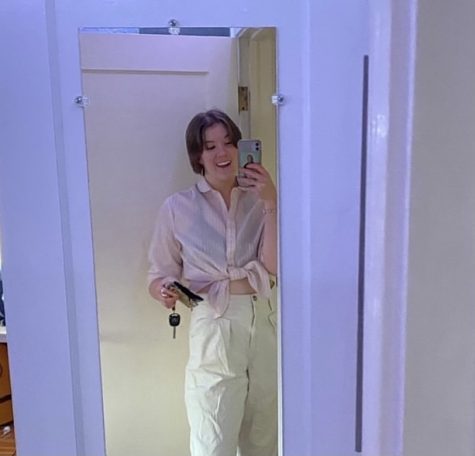Political Pieces: thrifted clothes are more than just additions to a wardrobe
The politics and controversy behind thrifting as a trend
“Since I’m underage I can’t vote, and I can’t really use legal power to influence policies I care about, but one thing I can do is change my personal actions,” sophomore Alice Whiteside said, “so I like thrifting because it’s good for the environment, and I also donate my clothes when I’m done with them instead of just throwing them away because it keeps the cycle going.”

Whiteside’s approach to a cycle of sustainability and unique items found at thrift stores is an experience that many West students can relate to, as thrift shopping has consumed the clothing scene among high schoolers during quarantine. But do high school students browsing the shelves of a second-hand shop really have a chance of making a dent in the massive piles of cheaply made clothing piling up in the landfills of the United States?
The Environmental Protection Agency (EPA) estimates that Americans toss over 11,000 tons of textiles and clothing in the bin every year. To put that in perspective, imagine an entire garbage truck of clothes being dumped into a landfill every second. Thrifting is able to cut back these numbers by the tons, which is no small feat. Buying and donating second-hand clothes guarantees that less synthetic, non-biodegradable fast fashion will end up sitting in a landfill for what could be hundreds of years. Additionally, 1,800 gallons of water, hundreds of pounds of pesticides, and an amount of greenhouse gases equivalent to driving a car 80 miles are being released into the air just for one pair of jeans to make it to your closet. So, by buying jeans from a thrift or consignment store, you’re not only saving money, but also greatly reducing the carbon footprint made from clothing consumption.
With the popularity of second-hand shopping for a more sustainable lifestyle also comes the normalization of thrifting. Junior Emma Bennett has experienced firsthand the effects of thrifting’s newfound attention.
“I definitely feel more comfortable thrifting and admitting that I thrifted my clothes now, because it didn’t use to be a popular thing, and people were not as approving of it as they are now,” Bennett said. “I still used to go but I wouldn’t mention that my clothes were thrifted. But now, everybody likes it and they go with their friends on the weekends for fun, and there’s not this taboo around it anymore.”
The stigma around thrifting has lifted a weight off the shoulders of many students that were thrifting long before it was a trend, and comfortably walking around a thrift shop without shame is now common practice of students like Bennett. Yet, there is the concern among many that the popularity of buying secondhand will make it difficult for those who have no other option to find what they need. Junior Maryn Chambers has heard some of these concerns among the buyers of Instagram thrifting accounts like the one she runs.
“Gentrification is actually a huge topic among the thrifting community because a lot of people get a lot of hate for it. What the haters don’t realize is how many clothes are thrown away in a year,” Chambers said. “Not everything that’s taken to Goodwill can be sold. They just throw it away. I can go to Goodwill and take three carts full of clothes, and there will always be more to replace them. It could get out of hand, but I really doubt it because there are just so many clothes.”
Others, like Whiteside, think that thrifting is advantageous as a whole, but it would be best if the trend were to lose its popularity for the sake of gentrification.
“With gentrification, it would probably be beneficial if some of the buzz dies down,” Whiteside said, “because for a lot of time people were made fun of for shopping at Goodwill, and I just hope that if the buzz and trend die down, the stigmatism around thrifting will continue to stay away.”
As far as stigma goes, thrifting has a complicated relationship with many. There are a large number of people who continue to have an aversion towards it despite its recent popularity. Some believe thrifting is dirty, or even that the clothes are nothing but older, ugly pieces that no one wants. Yet thrifters like Bennett are able to find beauty in even this concept.
“I do buy the ugly things from old people,” Bennett said. “I have things that I have looked at and thought, ‘this is so ugly. I have to have it.’ It’s mostly chunky sweater vests and stuff that I like, or things with weird graphics. I have a crazy cat lady shirt that I just really like. Part of it is also just that no one else has that.”
Whiteside agrees the ability to find trendy, in-style clothes is not necessarily why she finds thrifting such a great pastime. All the thrifters concur that you have to keep an open mind.
“People that don’t think you can find cute clothes while thrifting, come with me,” Whiteside said. “Let’s go together. It kind of takes an eye and you have to know your style and take the time to do a bit of digging, and the sections that you think you’re going to find things in you probably won’t, so you have to check all the racks.”
An open mind and a good eye aren’t the only things you need while thrifting, though. Determination to develop your style is also a useful tool, according to Junior Cadence Schuerger.

“Make whatever you find at the thrift your style. In my opinion, that’s kind of the point of thrifting,” Schuerger said. “If you’re going to go with stuff that you know is in style then you can just go to Target or Walmart or big stores that sell clothes like that. So when you go thrifting you have to find things and develop a different style.”
As a minority among thrifters, Schuerger is one of very few guys who enjoy thrifting. A study done by the Mobile Marketing Association found that women are much more likely to shop at second-hand stores than men. There seems to still be something keeping the trend from reaching the men of West. Thrifting may not be everyone’s taste, but why is the popularity among girls versus guys so heavily skewed?
“Guys’ clothing is kind of thought to be a much smaller realm of possibilities of what you can wear,” Schuerger said, “and that just makes people think, ‘Why would I go thrifting when I can just get my jeans and t-shirts literally anywhere?’ They don’t see the need to go thrifting, but in reality, the men’s sections are usually huge at thrift stores.”
Second-hand stores in Oregon are plentiful, and there are many places that students can stop by if they’re curious about what thrifting can be like and why exactly the thrift renaissance was sparked and spread so rapidly among Generation Z. The idea of a low cost, sustainable, and unique way to develop a new aesthetic is compelling to many high school students, and the trend of thrifting may become common practice in years to come.
“Especially with our generation,” Chambers said, “we have the awareness of fast fashion and how big industry is bad. Sure not everyone is shopping at thrift stores, but people are more aware, so I don’t think that people who really want to keep going and finding unique things will ever stop thrifting.”